Auke Visser's International Esso Tankers site | home
BATTLE BY MOONLIGHT
SS Esso Aruba
EN route from Guiria, Venezuela, to New York with a cargo of 104,170 barrels of Diesel fuel, the Esso Aruba joined a convoy at Port-of-Spain, Trinidad. Sailing from there August 23, 1942, the convoy had reached a point about 120 miles south southeast of Guantanamo, Cuba, on the night of August 27. At 11 p.m., in bright moonlight, the naval escort began a battle with attacking submarines - at least one of which was reported sunk in the hour and a half of fighting which followed. A U-boat finally broke through the cordon and 3 vessels were torpedoed in quick succession. Two of them were sunk - the Dutch flag tanker Rotterdam, owned by N. V. Petroleum Industrie Maatschappij, a Netherlands affiliate of this Company, and the San Fabian, of the Eagle Oil & Shipping Company, Ltd., a British flag tanker.
Nearly Broke in Two
The Esso Aruba, carrying the convoy commodore, was the third ship struck; she was torpedoed on August 28 at 12:43 a.m. The explosion opened a gaping hole in her side and she was in danger of breaking in two, but her en-gine and steering gear, by great good fortune, escaped damage. She was able to remain with the convoy until it approached Guantanamo, when she limped into the bay and was beached. The attack did not cause any fatalities or serious injuries among the ship's personnel.
After the salvage of most of her cargo, temporary repairs enabled her to sail for Galveston, Texas, where permanent repairs were made.
The Esso Aruba, completely restored, was returned to service February 13, 1943.
The SS Esso Aruba, ex Pan Bolivar, was built in 1931 by Swan, Hunter & Wigham Richardson, Ltd., at Wallsend, England.
A single-screw vessel of 15,145 deadweight tons capacity on international summer draft of 28 feet, 8 7/8 inches, she has an overall length of 500 feet, 7 inches, a length between perpendiculars of 483 feet, a moulded breadth of 65 feet, 3 inches, and a depth moulded of 36 feet, 9 inches. With a cargo carrying capacity of 107,569 barrels, she has an assigned pumping rate of 4,000 barrels an hour.
Her triple expansion engine, equipped with exhaust turbine and supplied with steam by three Scotch boilers, develops 3,800 indicated horsepower and gives her a classification certified speed of 11.1 knots.
At the outbreak of war in Europe the, Esso Aruba was en route from Aruba to New York, where she discharged 92,617 barrels of crude and fuel oil on September 8, 1939. Her master was Captain Eric R. Blomquist and Chief Engineer William O. Wilkinson was in charge of her engineroom.
Remarkable War Record During the war period' the Esso Aruba delivered the enormous total of eleven million barrels of vitally important oil, in 116 cargoes. All were crude or fuel oil, loaded in the hazardous Caribbean and Gulf of Mexico areas. On the 116 voyages, 86 cargoes were discharged at New York, 4 at Cristobal, Panama Canal Zone, and 2 at Key West; 24 were loaded at Guiria and Caripito and discharged at Aruba. The vessel was time chartered to the War Shipping Administration at Key West on April 20, 1942.
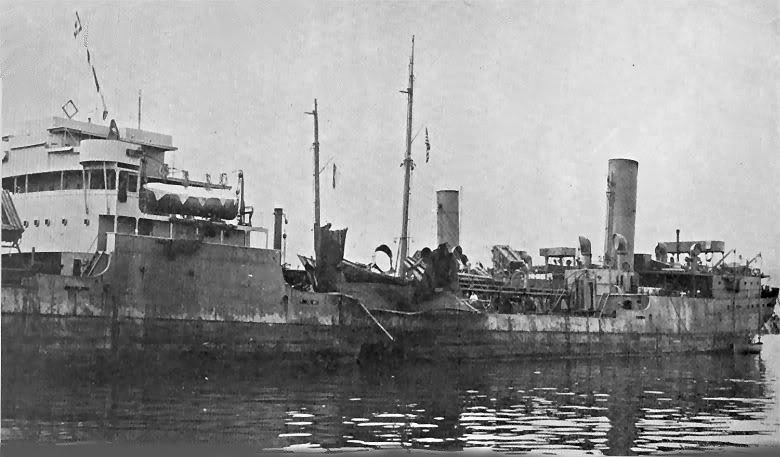 Outboard view of the torpedo hole in "Esso Aruba", port side, showing deck hove up.
The Esso Aruba's transportation record from September 3, 1939 to V-J Day, September 2, 1945, was in summary as follows:
The wartime masters ot the Esso Aruba were Captains Eric R. Blomquist, Robert T. Larsen, Garden Dwyer, Patrick S. Mahony, William J. Manning, John B. Petterson, Chester S. Swanner, Frank Pharr, Aage Petersen, Harry F. Murray, Martin Olsen, Alexander •J. Zafiros, and Abbo H. Kooistra.
Her engine department during the war was in charge of Chief Engineers William O. Wilkinson, Knut Grandall, Peter Olsen, Fred Lewis, Horace L. Wilson, James L. Gibbs, William L. Naughton, and Thor O. Sandin.
Captain Frank Pharr's report gave the following eye-witness account of the torpedoing and the runing fight with enemy submarines:
"Armed with two 50-caliber machine guns, one on each wing of the bridge, and with a 5-inch gun aft, we sailed from Guiria, Venezuela, on the afternoon of August 15, 1942, with a crew of 41 and 13 U. S. Navy gunners. The ship carried 104,170 barrels of Diesel oil intended for New York.
"We first called at Port-of-Spain, Trinidad, where we arrived about 6 p.m. and awaited orders to proceed. On August 22 the naval authorities instructed me to get ready to leave the following morning. The convoy commodore, Commander Comfort B. Platt, USN, came aboard about 5 p.m. to lead the formation. He was accompanied by 2 U. S. Navy radio operators and 3 signalmen.
Convoy Under Attack
"We left Port-of-Spain on August 23, at 8 a.m., in company with several other ships and under the protection of ade-quate air and naval support. The vessel was entirely blacked out at night.
"On the night of August 27 the weather was clear with a nearly full moon - visibility excellent - moderate easterly trade wind - moderate sea.
"At 11 p.m. our escort vessels began dropping depth charges one or two miles off our port quarter, indicating that the convoy was under attack. I was on the bridge with Commander Platt and Third Mate Jose A. Rodriguez. Able Seamen Roberto Rodriguez, Donald H. Cunningham, and James J. Adcock, and Ordinary Seaman Julius T. Bellgard were on lookout on the bridge and at the foc'sle head.
"Shortly after the depth charge explosions, there was heavy gunfire in the same vicinity. Tracer bullets were clearly seen to port and the escorts dropped more depth charges.
"Submarine Disposed Of"
"At midnight the watch was changed. Able Seaman Jack Miller relieved the lookout on the foc'sle head; Able Seaman Howard Caldwell took the wheel, and Ordinary Seaman George A. Hiscock stood watch on the starboard wing of the bridge. The convoy commodore and I remained.
"About 12:30 a.m., August 28, the gunfire subsided and shortly afterward one of, the escort flashed the signal 'Submarine disposed of.'
"Esso Aruba" Was Third
"At approximately 12:40 a.m., the ship in the following row and next column to port, the San Fabian, was torpedoed. I distinctly saw her settle by the stern. The vessel ahead of her in column and abeam of us to port, the Rotterdam, was the next victim.
She was hit at 12:43 a.m. A huge fire flared up from the explosion.
"Almost simultaneously the Esso Aruba was struck on the port side. Our position was Latitude 17° 55' North, Longitude 74°50' West, or about 120 miles south southeast of Guantanamo, Cuba.
"The torpedo entered No. 6 tank and blew up inside the ship. The deck over the tank was blown 20 feet into the air.
"I immediately rang the general alarm, summoning all hands to their boat stations, and ordered the engine stopped."
The crew proceeded to the lifeboats with good order and discipline. A 16 year old messboy, quartered about 30 feet from the point where the torpedo struck, slept through the explosion and general alarm and finally had to be dragged from his bunk.
Steward Richard Taylor sustained a head injury when he was thrown from the cot on which he was sleeping on deck. No one else was injured.
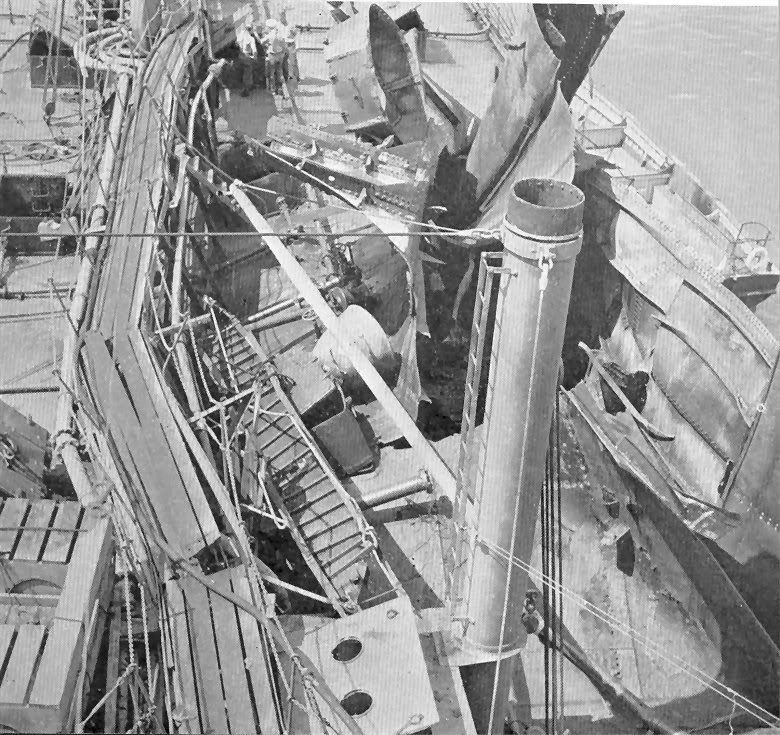 The terrific force of the torpedo explosion is illustrated in this view of the "Esso Aruba" looking aft from bridge - steel plates ripped up and curled back from opening in deck
Ship Sagged - Sea Prevented Capsize
To continue Captain Pharr's account: "Accompanied by Chief Mate Alexander Marra and Bos'n Henry Pawlik, I went to inspect the damage. The starboard side of the ship was bulged out about 3 feet. The vessel sagged in the middle and was nearly broken in two. Port tanks Nos. 6 and 7 were entirely open to the sea. Water flowed into these tanks to replace the oil lost, and this prevented the Esso Aruba from capsizing.
"Chief Engineer Horace L. Wilson reported that the machinery was still in good condition. I ordered the engine started and we resumed our course. With her steering gear intact, the ship could still be handled; although she had a slight list to port and her speed was reduced, we were able to keep up with the convoy until ordered to put in at Guantanamo.
"At 8 a.m., the convoy commodore and his men left the Esso Aruba to board another vessel and continue the voyage. At 4 p.m., August 28, we dropped out of the convoy as we approached Guantanamo Bay."
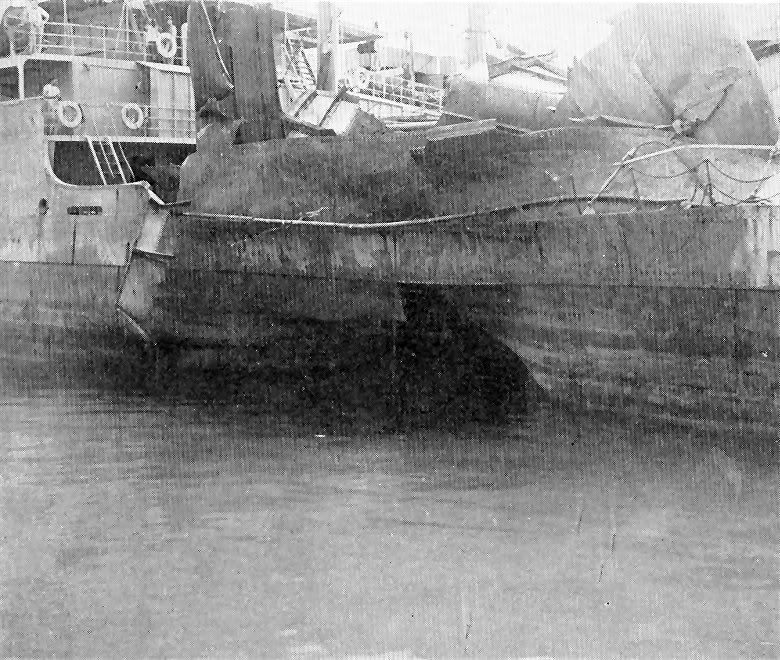 Close-up of the torpedo hole in port side of "Esso Aruba"
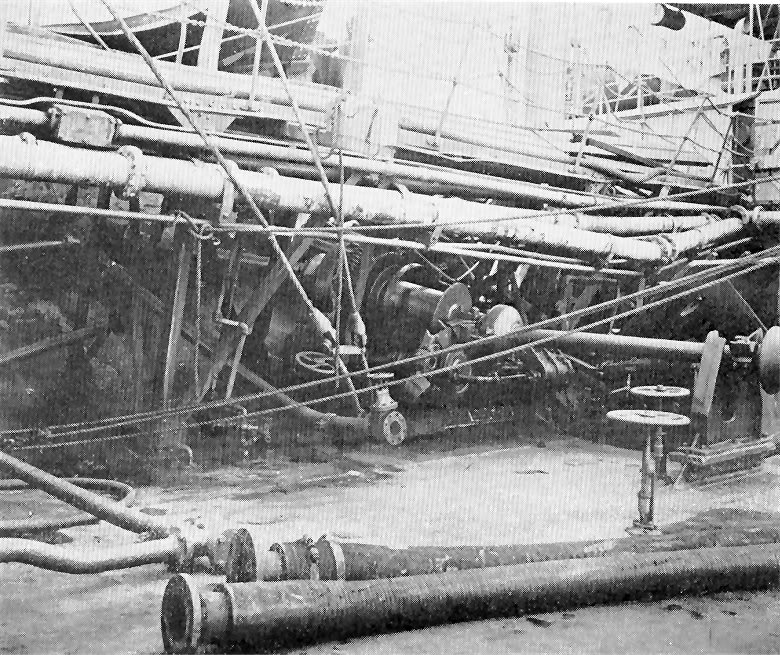 Damage to deck, deck structures, and machinery located directly above torpedo hit
Put Ashore at Guantanamo
The commandant of the naval base feared contamination of the harbor, but he permitted the Esso Aruba to anchor in the bay; she was in danger of breaking in two if she remained outside. On the morning of August 29, the ship was run aground to take the strain off her bottom plates and the commandant ordered her cargo transferred to another tanker, the Cities Service Missouri.
However, the Esso Aruba's pumps could not be used and the Cities Service Missouri was unable to take suction with her own main pumps. Therefore, on August 30 the wrecking tug USS Montcalm came alongside to assist. The Montcalm was able to transfer the cargo into the Cities Service Missouri. In order to empty the tanks it was necessary to run in water to raise the oil to a level from which the pumps could lift it.
The transfer of cargo was completed September 8. More than 60,000 barrels were salvaged in this manner and later discharged by the Cities Service Missouri at New York.
After the Esso Aruba's tanks were cleaned and gas-freed, she was shifted to a Navy dolphin at Guantanamo. Material and stores were received from the F. H. Bedford, Jr., and temporary repairs were begun on September 28. The method of hull reinforcement was worked out by Mr. Guy L. Bennett, at that time the Company's Port Engineer, in cooperation with the Hull Department of the Guantanamo Naval Base. Sailing November 17, 1942, under escort, she arrived at Galveston on November 25.
Permanent repairs were made at Galveston, and the vessel re-entered service February 13, 1943, when she loaded, at Baytown, 98,240 barrels of Navy fuel oil. This cargo was delivered at New York on February 25, 1943.
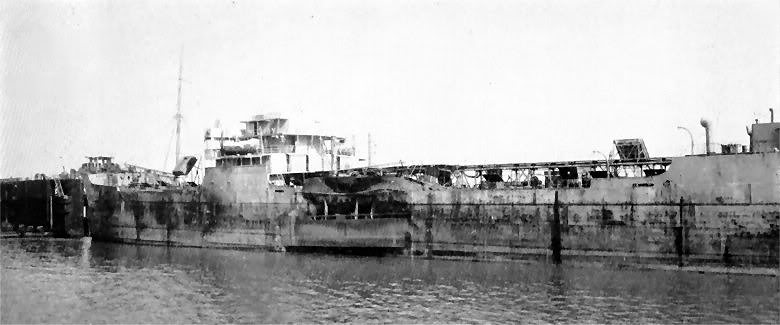 "Esso Aruba" at Galveston, Tex., showing temporary hull repairs made at Guantanamo.
Captain Frank Pharr entered the Company's service as a chief mate on April 9, 1920. He became master March 6, 1924.
Chief Engineer Horace L. Wilson joined the Company as a third assistant engineer October 18, 1916. He was promoted to chief engineer on February 19, 1920.
Three members of the crew of the Esso Aruba at the time she was torpedoed survived enemy attacks while serving on other tankers: Second Mate Avon O. Helms (third mate, I. C. White, September 27, 1941); Third Mate Jose A. Rodriguez (Heinrich v. Riede-mann, April 16, 1942); and Storekeeper John L. Chappelle (Esso Baton Rouge, February 23, 1943).
While commanding the Esso Aruba, Captain Martin Olsen received the following letter of commendation:
HEADQUARTERS COMMANDER ALL FORCES,
ARUBA-CURACAO
Fort Amsterdam,
Willemstad,
Curacao, N. W. I.
15 December 1943
From: Commander All Forces, Aruba-Curacao
To: Master Esso Aruba
Subject: Station keeping and join-up, efficiency
in.
1. On 7 December 1943 your vessel departed from Aruba with eight other tankers in convoy to join a main convoy.
2. A report has been received from our Escort Commander complimenting you for the very efficient and excellent manner in which your vessel was handled and for maintaining station in the join-up to the main convoy.
3. Commander All Forces also joins in extending his appreciation for the excellent manner in which your vessel was handled.
R. V. Mullany
by direction
Merchant Crew Survivors of the "Esso Aruba" - August 28, 1942
U. S. Navy Armed Guard Survivors of the "Esso Aruba"
|